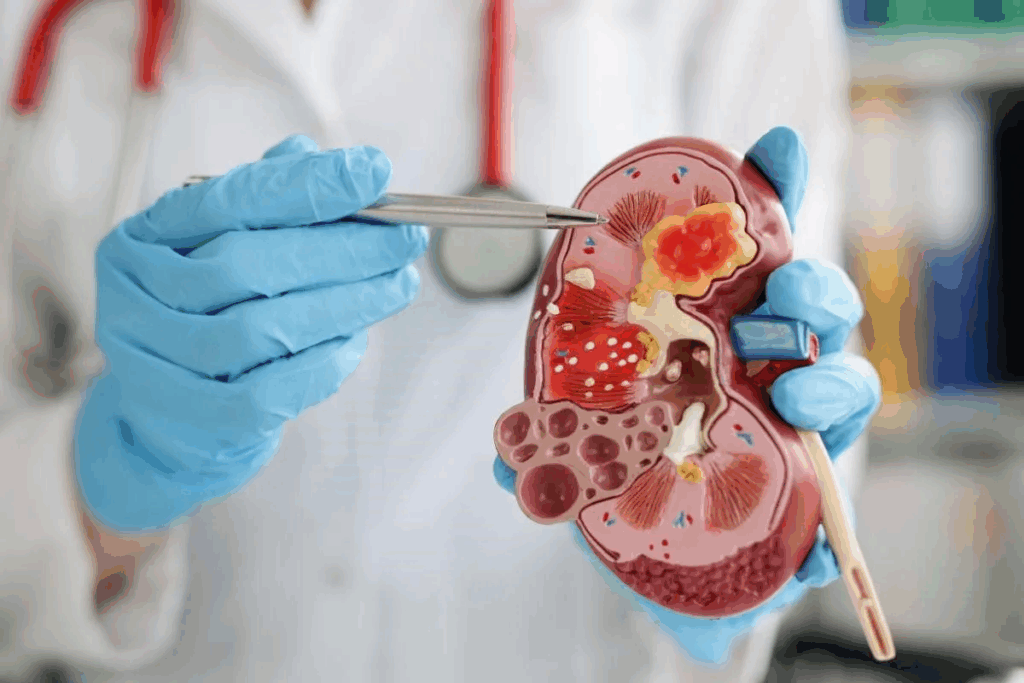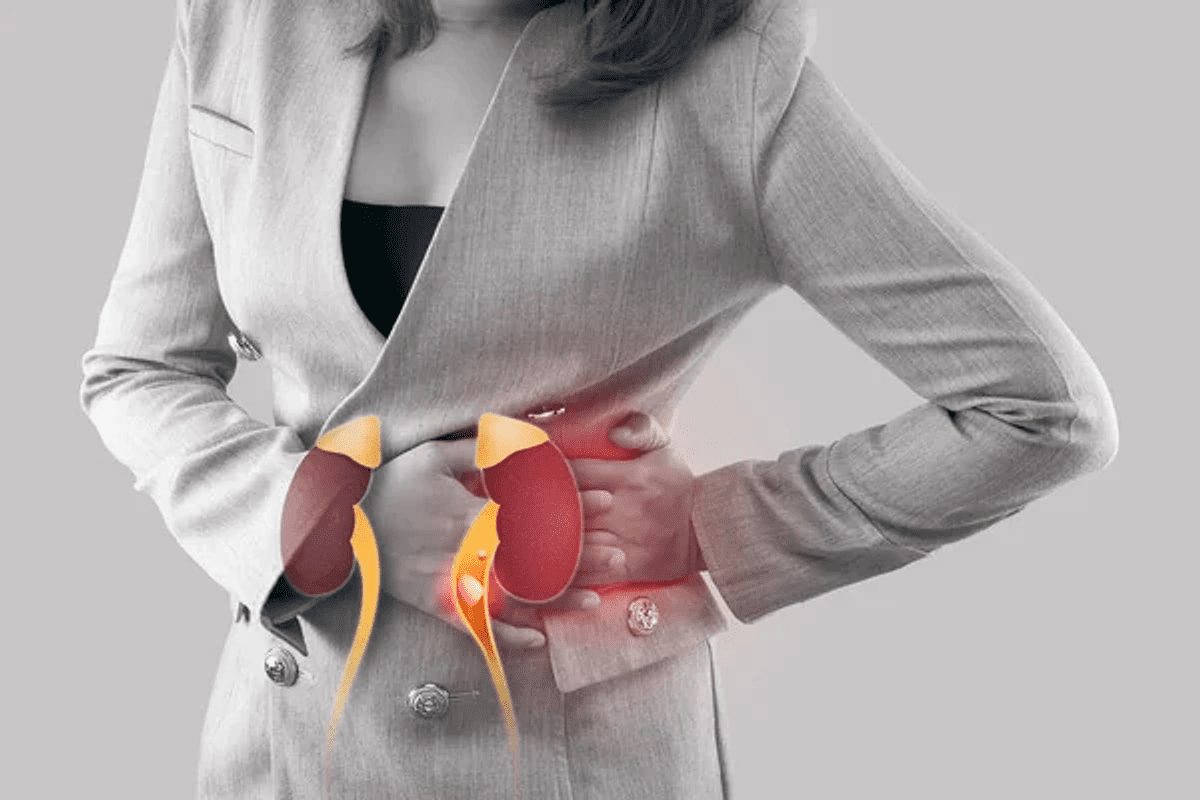Last Updated on November 25, 2025 by Ugurkan Demir

Kidney stones are small, hard mineral deposits. They form inside the kidneys when there’s an imbalance of water, salts, and other substances in the urine.
Learn 5 essential facts about kidney and ureteral stones. Understand their causes, symptoms, and the relationship between the two.
The exact cause of kidney stones is not always known. But, certain factors can increase the risk.
The symptoms of kidney stones can vary. They often include severe pain in the side or back, nausea, and vomiting.
Treatment for kidney stones depends on the size and location of the stone. Small stones may pass on their own. But, larger stones may need medical intervention.
The Nature and Formation of Kidney and Ureteral Stones
Kidney stones are hard deposits made of minerals and salts. They form inside the kidneys. These stones can happen when there’s an imbalance of water, salts, and other substances in the urine.
There are several types of kidney stones. These include calcium stones, uric acid stones, struvite stones, and cystine stones. Each type has its own causes and risk factors.
Calcium stones are the most common. They often happen when there’s too much calcium in the urine. Uric acid stones are more common in people who don’t drink enough water or have certain health issues.
Struvite stones are linked to urinary tract infections. Cystine stones are rare and usually happen in people with a genetic disorder.
It’s important to understand the causes and risk factors of kidney stones. Knowing the type of stone and its causes helps prevent them from happening again.

Kidney and ureteral stones are becoming more common all over the world. This increase is seen everywhere, making it a big health issue.
In the last 30 years, kidney stones have become more common globally. Now, more people are at risk of getting them. This change affects many different groups of people.
In the US, kidney stones are a big problem. About 1 in 11 people have them. Men are more likely to get them, but the difference is getting smaller.
The main age for getting kidney stones is between 30 and 50. Many factors contribute to this increase, like diet and lifestyle changes. It’s important to understand these trends to prevent more cases.
Kidney stones come in many forms, each with its own set of characteristics. Knowing these differences is vital for preventing and treating them.
There are several types of kidney stones. These include calcium stones, uric acid stones, struvite stones, and cystine stones. Each type needs a specific approach to manage it well.
Knowing the specific type of kidney stone is key. It helps in creating effective prevention and treatment plans.
Knowing what causes kidney stones is key to preventing them. Diet and genetics are big players in stone formation.
Eating too much animal protein, sodium, and sugar raises your risk. A balanced diet can lower this risk.
If your family has a history of kidney stones, you might get them too. Knowing this can help you take steps to avoid them.

Kidney and ureteral stones cause severe symptoms as they move. These symptoms can really affect a person’s life and need quick medical help.
Renal colic is a very painful cramping feeling. It happens when a stone blocks the ureter, causing pain. This pain is very bad, starting in the flank and going to the groin.
Characteristics of Renal Colic:
Patients with kidney and ureteral stones may also have other symptoms. These include:
These symptoms mean a person should see a doctor right away. This is to avoid problems like infection or kidney damage.
Symptom | Description | Clinical Significance |
Renal Colic | Severe, cramping pain due to stone obstruction | Hallmark symptom of kidney stones |
Hematuria | Blood in the urine | Common finding in patients with kidney stones |
Fever and Chills | Indicative of infection | Requires prompt medical attention |
Urolithiasis, or the formation of stones in the urinary system, is a big problem. It costs a lot of money for both individuals and healthcare systems around the world. The costs include direct medical expenses, lost productivity, and the pain and suffering people endure.
The costs of urolithiasis are huge. Direct medical costs include hospital stays, emergency visits, tests, and treatments. Indirect costs come from lost work time, affecting both the person and their employer.
Many things affect the economic burden of urolithiasis. These include how common the condition is, the cost of healthcare, and how much it affects someone’s work and daily life.
To lessen the economic burden, prevention is key. This includes changing diets, drinking more water, and managing underlying conditions. Also, better treatment plans and healthcare access can help lower costs.
In conclusion, knowing the economic impact of urolithiasis is vital. It helps in finding ways to manage and prevent it. By understanding the costs, healthcare providers and policymakers can work to reduce the financial burden on individuals and society.
Diagnosing kidney stones requires a mix of clinical checks and imaging tests. Non-contrast computed tomography (NCCT) is the top choice. It’s very good at finding kidney stones.
NCCT scans can spot stones of all sizes and types. This makes it a key tool in diagnosing kidney stones. Ultrasound is also used, mainly for those who can’t have radiation.
Laboratory tests, like urinalysis and blood work, are also key. They help in diagnosing and managing kidney stones.
For those with small stones, a conservative approach might be best. This method combines pain relief and monitoring. It lets the stone pass on its own.
Medical expulsive therapy uses medicines to help stones move. Alpha-blockers, like tamsulosin, relax the ureter’s muscles. This makes it easier for the stone to pass.
Pain control is key in conservative management. Doctors often use NSAIDs to ease pain from kidney stones.
Knowing when to get help is important. If you have severe pain, can’t urinate, or have infection signs, get medical help right away.
Understanding conservative management options helps patients make better choices. They can work closely with their doctors to manage their condition well.
When other treatments don’t work, surgery is needed. Doctors use methods like percutaneous nephrolithotomy (PCNL) and ureteroscopy.
PCNL and ureteroscopy are good for treating kidney stones. PCNL makes a small cut in the back to take out stones from the kidney.
Ureteroscopy lets doctors see and remove stones from the ureters. These steps are key for those who don’t get better with other treatments.
These methods help by easing symptoms and stopping more problems. But, like any surgery, there are risks. These include infection and harm to nearby tissues.
Preventing kidney stones requires a few key steps. Drinking lots of water is important. It helps to dilute your urine and lower the concentration of minerals that can cause stones.
Eating a balanced diet is also key. Focus on fruits, vegetables, and whole grains. Avoid foods high in oxalate like beets, spinach, and rhubarb. Also, keeping a healthy weight and not eating too much animal protein can help.
It’s vital to have regular check-ups with your doctor. This way, any problems can be caught early. By making these changes and watching what you eat, you can lower your risk of getting kidney stones again.

It’s important to know when to get medical help if you think you have kidney or ureteral stones. Getting help quickly can make treatment more effective and avoid serious problems.
If you have any of these symptoms, you need to see a doctor right away:
These signs could mean a serious issue, like an infection or a blockage. Seeing a doctor quickly is key to avoiding bigger problems and easing pain. If you’re showing these signs, go to the emergency room or call your doctor.
After a stone episode, you should check in with your doctor. They’ll make sure the stone is gone and talk about how to avoid more stones. Your doctor might suggest:
Regular check-ups are important to find out why stones keep happening and how to stop them. Working with your doctor can help you avoid more stones and keep you healthy.
Understanding kidney and ureteral stones is key to managing and preventing them. We’ve looked at what these stones are, how they form, and their types. We’ve also discussed risk factors, symptoms, diagnosis, treatment, and prevention.
Kidney stones are a big health problem with a heavy economic cost. The number of people worldwide with these stones is growing. It’s important to spread the word about the risks and symptoms to help catch and treat them early.
Preventing kidney and ureteral stones is possible through diet changes and staying hydrated. We stress the need for ongoing research into their causes and treatments. This will help lessen their impact on public health.
As we go forward, education and awareness about kidney and ureteral stones are vital. This ensures people get the right care on time. Together, we can lower the number of these stones and improve life for those affected.
Kidney and ureteral stones are hard objects made of minerals and salts. They form inside the kidneys or ureters. These stones can cause severe pain and other symptoms as they move through the urinary tract.
There are several types of kidney stones. Calcium stones are the most common, often linked to diet and medical conditions. Uric acid stones are related to diet and genetics. Struvite stones are often caused by urinary tract infections. Cystine stones are rare and usually occur in people with a genetic disorder.
Several factors can increase your risk of getting kidney stones. These include a diet high in oxalate, sodium, and animal protein. Medical conditions like hyperparathyroidism and genetic predispositions also play a role. Dehydration and certain medications can also contribute to stone formation.
The main symptom of kidney and ureteral stones is severe pain, known as renal colic. This pain starts in the flank and moves to the lower abdomen or groin. You may also feel nausea, vomiting, and see blood in your urine.
Doctors use imaging techniques like non-contrast CT scans or ultrasound to diagnose kidney stones. They also do laboratory tests, such as urinalysis, to check for blood or infection.
Treatment options vary. They can range from conservative management to surgical interventions. This includes minimally invasive procedures or percutaneous approaches for larger or obstructing stones.
To prevent kidney stones from coming back, make dietary changes. Drink more fluids and eat less sodium and oxalate. Medication therapy can also help control underlying conditions.
Seek medical help right away if you have severe pain, vomiting, fever, or trouble urinating. It’s also important to follow up after a stone episode to prevent future occurrences.
Urolithiasis has a big economic impact. It includes direct healthcare costs for diagnosis, treatment, and management. There are also indirect costs due to lost productivity.
Yes, diet is very important in preventing kidney stones. Eating too much sodium, oxalate, and animal protein can increase your risk. But, a balanced diet with enough hydration can help prevent stones.
National Center for Biotechnology Information – 5 Essential Facts About Kidney and Ureteral Stones. Retrieved from https://www.ncbi.nlm.nih.gov/pmc/articles/PMC9876543/
Subscribe to our e-newsletter to stay informed about the latest innovations in the world of health and exclusive offers!